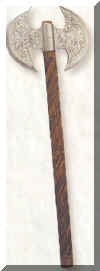Axes, Lances, Spears and Polearms used in Combat
Axes | Spears
and Polearms | Lances
Axes were first made in the Palaeolithic era and have changed in design over
the centuries since then. At some point in the past, the additional power of
using a shaft with the axe head was discovered and axe heads with holes for
the handles were being made around 8000-3000 BC.
Also, the high quality of the axe head finish became more common and the
skill of making a more efficient blade with curved and double-bladed heads
were in use by 2000 BC.
With the discovery of Bronze, axes became more elaborate and through the
years after, the ways in which to attach the axe head to the shaft went through
many changes.
There are different types of axes with some being one-handed single blades
and two blade axes (double head) with two-handed versions of the smaller
versions as well.
Axes were also regarded as a symbol of power and many kings and nobles had
axes which were highly decorated or of an unusual design.

Double-handed two head
axe
The spear began as a simple wooden pole with a sharpened end and this
eventually grew to having a dagger-like spear head fixed on to the end of the
pole.
The spear could be of two groups, a thrusting spear or a throwing spear.
With the spear being a thrusting spear, it would have the advantage of weight
and reach. If the spear is used as a throwing spear, its weight and length
would increase its reach and the extra weight would keep the spear point at
the front in flight and allow the spear to hit the target with force enough to
penetrate.
Once the idea of having a head on the spear shaft was adopted, many designs
began to appear. The simple fork and trident were multiple sharp pointes on
the head of a spear, much like a 'fork'. These extra points made the spear
more deadly. The 'Partisan' spear was a spear with wing shaped cutting edges
below the head to cause more serious wounds. A poleaxe had an axe head fixed
to the spear so as to give longer reach. The glaive is a long single-edged
blade with a point attached to the shaft. The halberd is an axe blade that is
formed underneath the spear head.
With these weapons, the user has the choice of thrusting or cutting, while
the hook on the reverse side of the axe could be used to pull a man off a
horse or to trip up an opponent.
Polearms became obsolete with the introduction of firearms but they are
still used as a ceremonial symbol to this day.
The Lance was a spear that was carried by a horseman which, at first, was
carried two-handed. With the introduction of the stirrup into Europe around
the 6th to 8th century made a considerable difference as it allowed the rider
to brace themselves and hold their lance under the arm and mount a charge.
This allowed the rider to deliver a full force blow with the momentum of his
mount rather than with the force and strength of only their arm and lance.
The lance was originally a broad spear-head but changed to a simple pointed
shaft that gradually thickened towards the butt, then it thinned to form a
grip for the rider and finally thickened again to provide counterbalance and
weight to the first long part of the lance shaft.
With the decline of the knights in the 15th and 16th centuries the lance
faded out and was used sporadically in combat up until the Second World War.
For further information on these and other weapons and
armour described here in these web pages, see my bibliography
page.
Click on the Back icon to return to the Weapons page or
Next to go to the Ranged Weapons page




